On Making a Chinook Canoe
Columbia River Basin
|
NEW ESRI StoryMaps: What's On Our Shelves & NWNL Song Library & No Water No Life ESRI |
Columbia River Basin
John MacCoulum
Canoe-maker
Alison M. Jones
NWNL Director and Photographer
The story of the Lower Columbia has always been centered on water – and cedar. After our 2007 “Source to Sea” Columbia River Expedition, NWNL joined the family of William Clark (of Lewis and Clark fame) as they “righted an old wrong.” Anxious to return east after 115 rainy, winter days, Clark stole a sea-going, high-bow/high-stern canoe from the Chinook on March 21, 1806, the eve of his departure. Seven generations later, the Clark family gifted “Klmin,” a new, but traditional, sea-going canoe, to the Chinook Nation. Below are some of the accounts shared with the Clark Family and their guests.
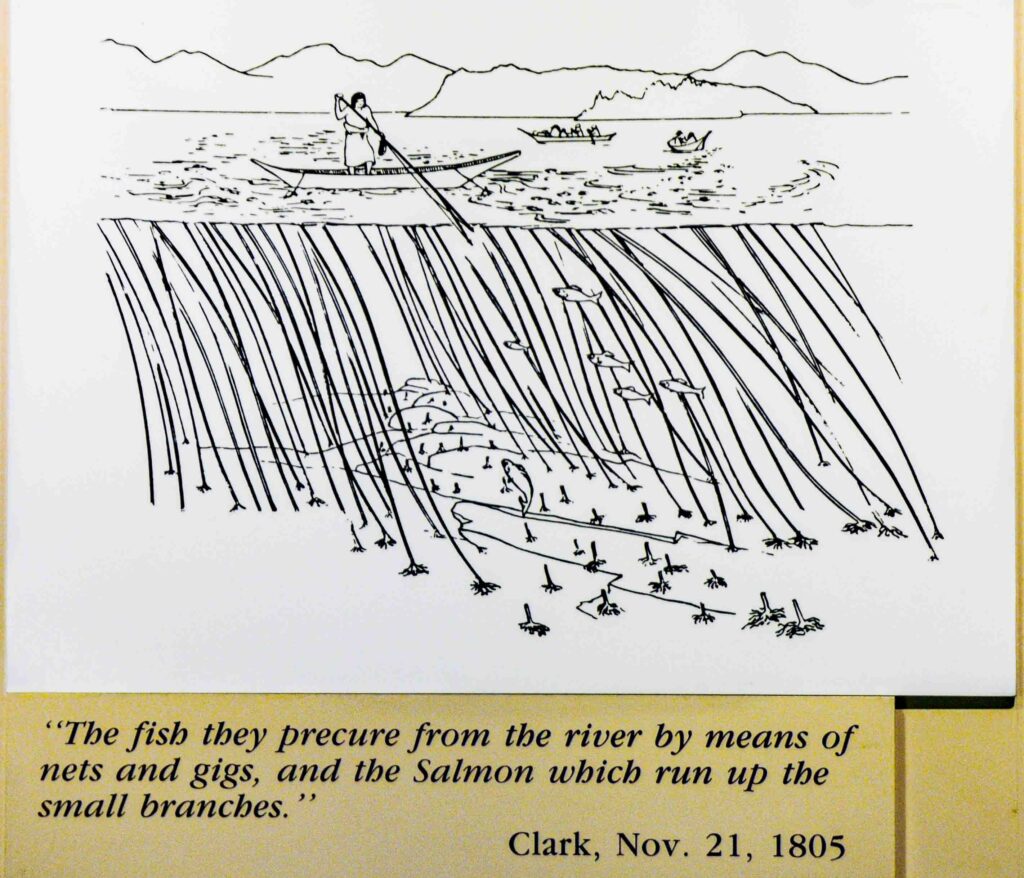
NWNL John, congratulations for having built this beautiful canoe! Please tell us a bit about these sea-going Chinook canoes that were used so successfully here in the Columbia River Estuary.
JOHN MACCOULUM This new canoe we’re celebrating today is pretty much an exact replica of the Scarborough Canoe, carved right here in 1905. I’m told it was carved on that beach right down there on the Columbia River. The very successful Chinook model is a little bit more extreme than some of the other West Coast canoes. They have a little more flair, more stability and it can carry more people which equals more engine power. It’s very fast.
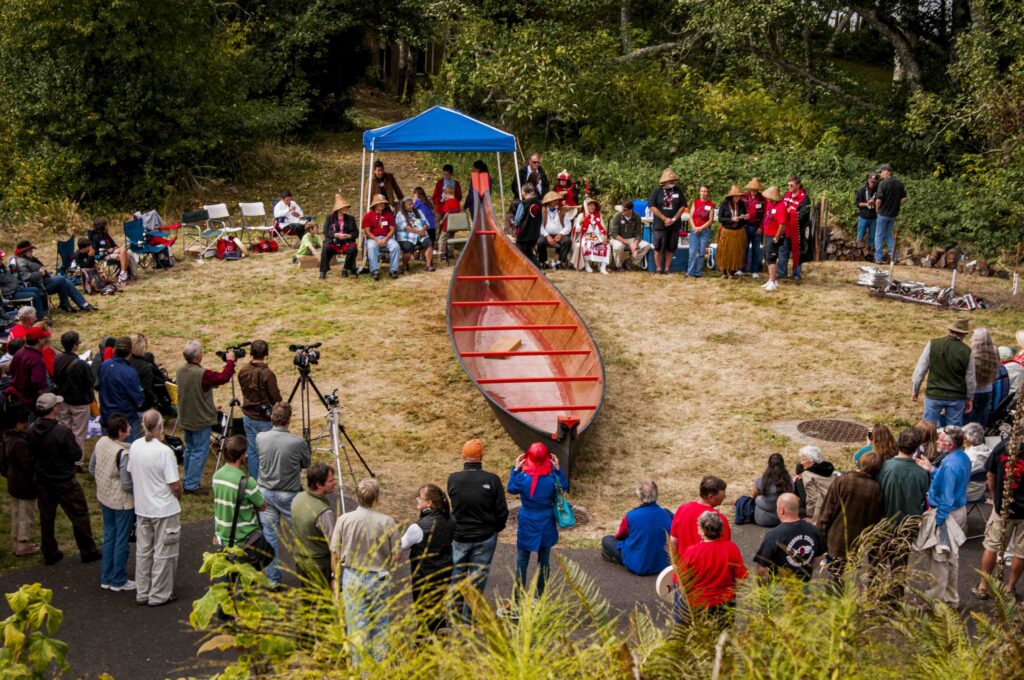
Its mathematical underpinnings that you can’t see or quite measure are in exact agreement with modern racing canoes, other racing ships and aircraft carriers. The Chinook achieved amazing results just by storing their design information over the generations.
These particular kinds of canoes with sharp ends would be used where there is no rough “white water” – but where there are a lot of cross winds. The fins that help control the change in the rake fore and aft, and they control the way the wind moves the boat.
NWNL How did the engineering of the Chinook canoes compare to the Lewis Clark dugouts?
JOHN MACCOULUM As far as I know, the Lewis and Clark dugouts were just sort of salad bowls. They were not idiots, but they were on the run (inaudible) pickup truck to get them down the river and a lot of the canoes in the East weren’t steamed open like this. The thinking is that the people who had moved down from Alaska using (inaudible) that were walrus side covered on a frame. Some of the earlier paint jobs would show the black coming over like this and then lining [background noise].
BYSTANDER Your canoe is gorgeous. This was an ocean-going craft, right?
JOHN MACCOULUM Yes. The supposition is that these came down from Alaska. The Chinook knew what they wanted in terms of the canoe’s shape, and they carved it in cedar. It’s an amazing tradition. There are no other flat-bottom dugout canoes in the world. They are very highly regarded in oceans worldwide as is a very seaworthy shape.
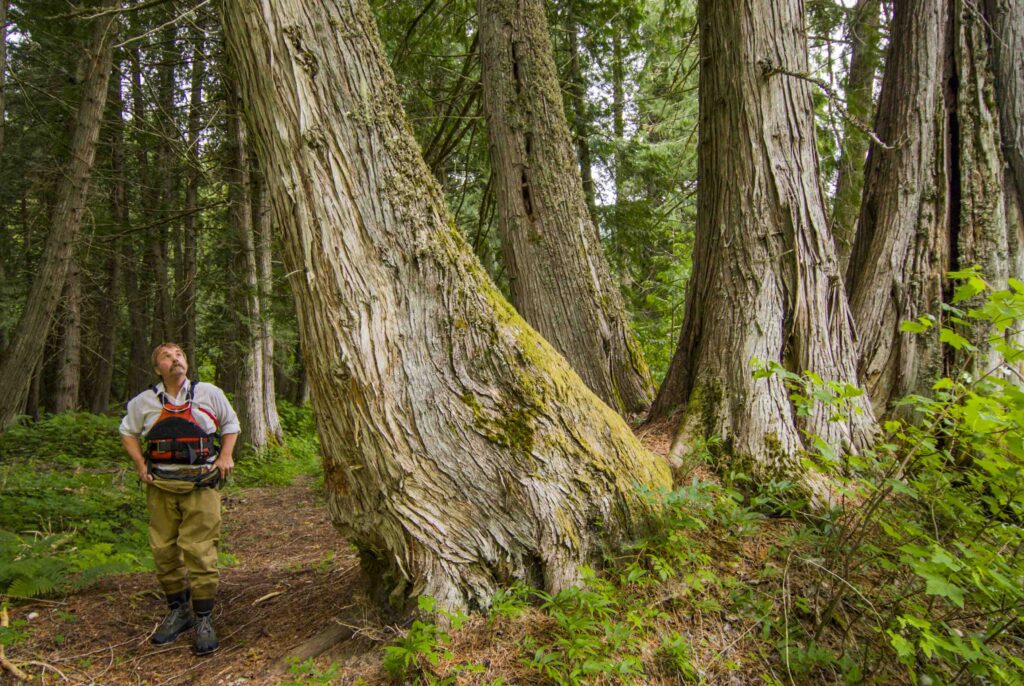
NWNL This estuary of the Columbia is known for its difficult waters to navigate.
JOHN MACCOULUM Oh, yes, yes, this is one of the roughest areas to navigate.
NWNL Thus, the engineering used in the Chinook canoes helped them cope with the estuary’s bars and rough waters there.
JOHN MACCOULUM The extra flair gives it extra stability. I made a 21-footer for Tony Johnson [a Chinook tribal leader]. It broached when they were out in the surf. A wave caught them from behind and flung them sideways to the wave. Normally, that’s it. Done. But the canoe surfed sideways on its side. As they held the paddles out, it slid sideways down the wave, so they lived to tell the tale. The curving of the bow and the stern comes out thus. I was told that it should be absolutely “dead flat” when it was done. Right just at the edge is an aesthetic point. To carve these dry cedar end pieces, I had to spray them. I’d spray the canoe with mist as I got it into its final shape and the spray would come squirting right back in my face.
The ears and the tail are like one turbine blade. They deflect the water exactly at right angles which imparts momentum for the rest of the water that might be attacking the boat. When Tony was out in the surf, a wave broke over the stern, and the tail of the canoe split it. Tony leaned back and the wave showered over his shoulders but didn’t come into the boat.
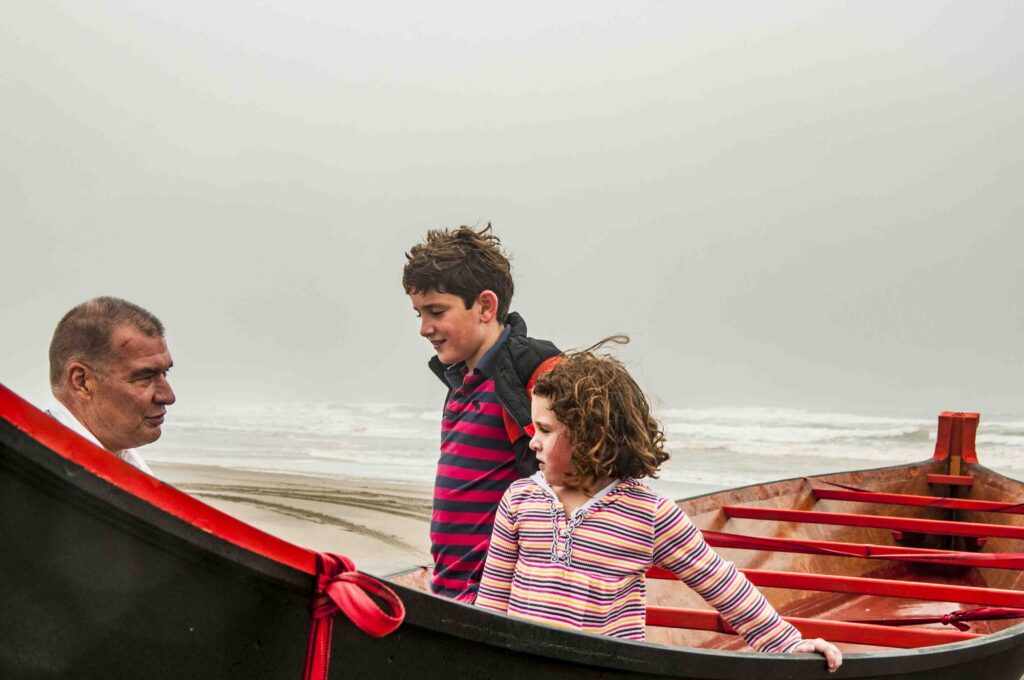
Every design detail about this boat has an esthetic story and an engineering reason behind it. The Chinook may not articulate their engineering reasons, but they certainly did know how to build their canoes. There are all kinds of things you cannot see about a boat- – metacentric height, prismatic coefficients and all that! You can’t say, “Well, it’s so many cubic feet in the curve of midship areas and the underwater sections.” But up and down the coast, from Alaska to Central Oregon, they all conform to that one design — even if they have different widths and styles, they are pretty uniform.
NWNL What are the materials you used?
JOHN MACCOULUM The original Chinook canoe had fairly thick cedar bottoms. These are narrower than a lot of canoes. They found that weight down low and spread out is essential to adding to the stability because it lowers the center of gravity and keeps the canoe from tipping so much. When the weight is spread out, it is like a ice skater who’s spinning. When they bring their arms in, they spin faster. Likewise, if you spread the weight of the canoe out, it spins slower. The bottom is 1-1/2” thick fir plywood bottom. It’s very heavy and way stronger than it needs to be. But rather than including ballasts, the weight is in the boat, as with dugouts. This mahogany is quite strong.
Then we had to steam the canoe in the back to get this shape. Eventually we’ll trim this back to be about this wide to form the identical shape that was in the dugouts.
It would be hard to see the difference between this and a dugout when I’m done.
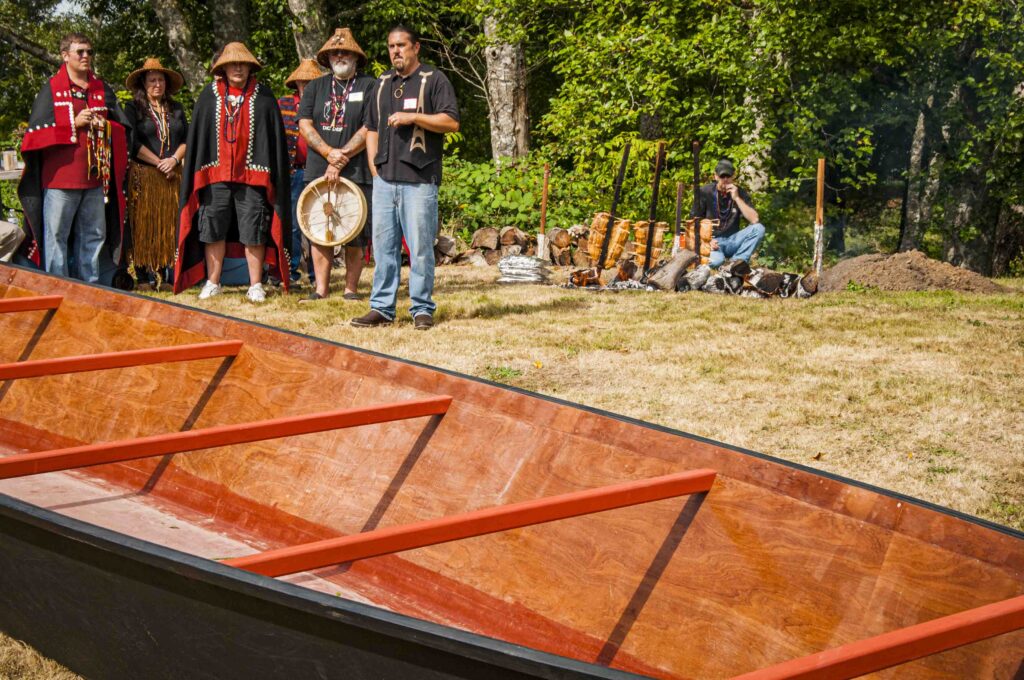
Today I’m crying inside because all the pretty details aren’t done yet. But everybody’s telling me to be quiet and be nice today.
NWNL It must be hard when you feel it’s not quite ready. But you must know that we are all excited to see this boat!
JOHN MACCOULUM Well, it is beautiful. Everybody’s telling so. It’s wonderful and kind of fun actually that people can see a little bit of the process.
NWNL What materials have you put into this canoe?
JOHN MACCOULUM There’s fir plywood on the bottom, Sapele-African mahogany on the sides, and there’s 10 gallons of epoxy on this thing. It has fiberglass sealing inside. The bottom is high-tech, 17-ounce biaxial cloth. It’s not woven. It’s two unidirectional knitted fabrics together. It’s got an epoxy covering on top of that with rock dust in it. It’s quite bullet-proof!
The shale dust is so that it slides along obstructions. There was a case where one of the 33-footers was out around Port Angeles. They were over a rock and an extra big trough just dropped them right down. They must have been weighed 3500 to 4000 pounds at the time. I talked to one of the pullers who was in the canoe that day and he had a shaken look on his face. He said, “That was a bad day.” But it only made a little divet in the bottom about as big as your thumb.
BYSTANDER It didn’t put a hole in it?
BYSTANDER No, no. It must have made a noise like the end of the world!
BYSTANDER Yeah. Those are amazing materials!
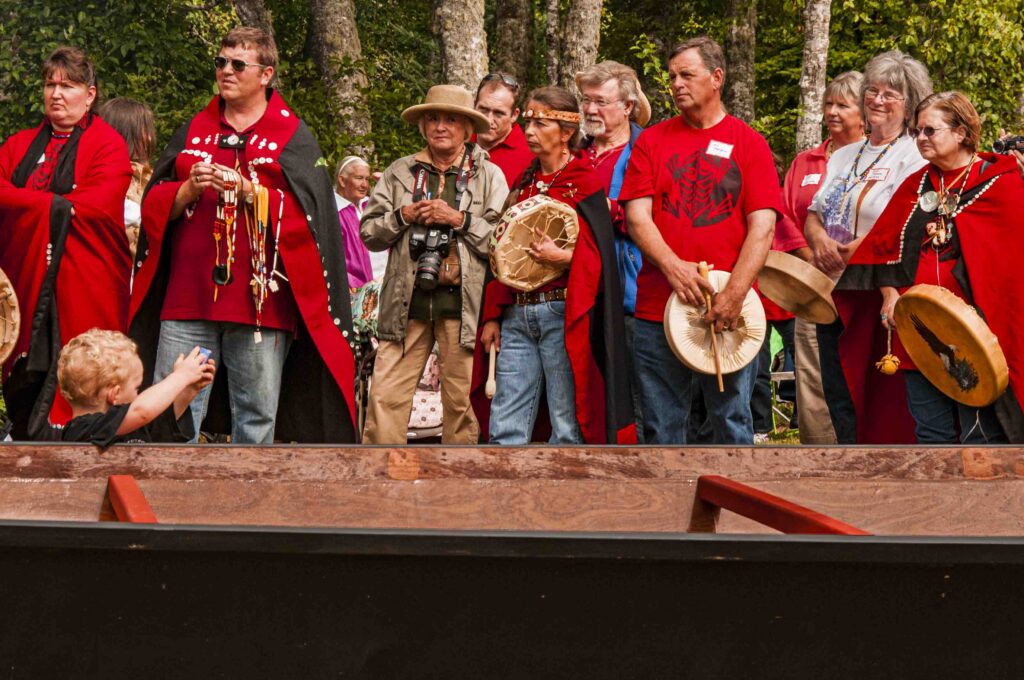
NWNL While you were building this canoe, were there special ceremonies, Chinook observances or prayers as part of the building process?
JOHN MACCOULUM No. It starts off fairly space age. There are composite tape seam joints with that aerospace wax stuff. Then towards the top, there is more cedar carving. The canoe has a heart – we made sure it has a heart. I’m told if the heart breaks, “Jump out! The canoe is doomed!”
NWNL Where is the heart and what is it?
BYSTANDER The heart is up here. It’s cedar. Every canoe has a heart. As Chief Ray Gardner said, “If it has a heart, it’s alive. It can be introduced as a member of the family.”
The grain of the heart doesn’t go this way, it goes this way. Anybody could just reach up and just snap it off. But it seems to have an effect on everybody, so they treat it very delicately. It would be a very, very bad thing to break that
NWNL John, thank you very much.
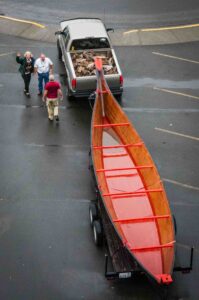
Posted by NWNL on December 7, 2023.
Transcription edited and condensed for clarity by Alison M. Jones.
All images © Alison M. Jones, unless otherwise noted. All rights reserved.
